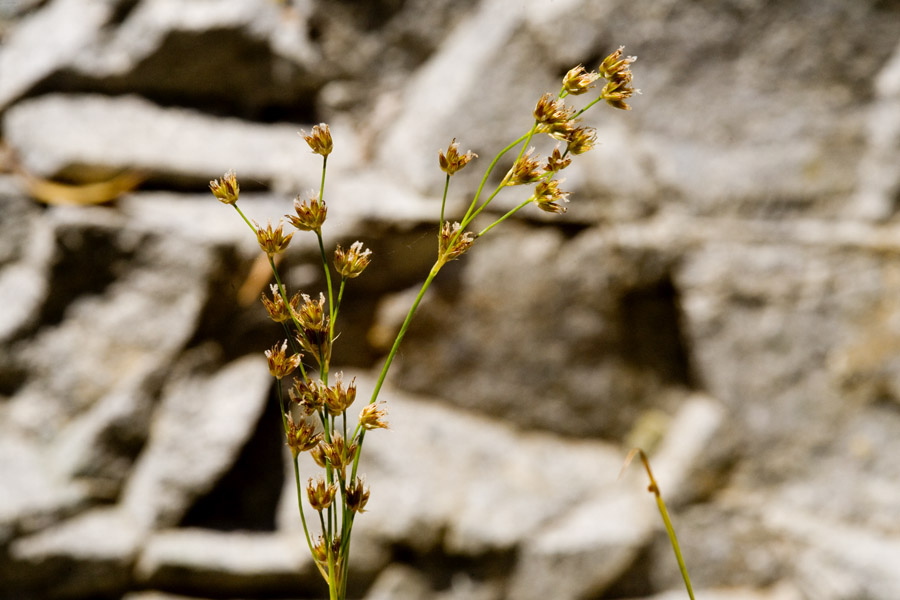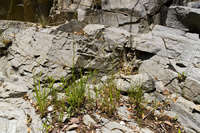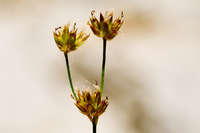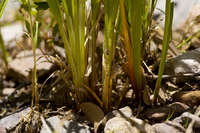|
|
|
|
Family: Juncaceae
swordleaf rush
[Juncus ensifolius var. major Hook., moreJuncus xiphioides var. macranthus Engelm., Juncus xiphioides var. triandrus Engelm.] |
Herbs, perennial, rhizomatous, 2--6 dm. Rhizomes 2--3 mm diam. Culms erect, 2--6 mm diam. Cataphylls 0 or 1--2, straw-colored, apex narrowly acute. Leaves: basal 1--3, cauline 2--6, straw-colored; auricles absent; blade 2--25 cdm x 1.5--6 mm. Inflorescences panicles or racemes of 2--50 heads or heads solitary, 2--14 cm, erect or ascending branches; primary bract erect; heads 3--70-flowered, obovoid to globose, 7--11 mm diam. Flowers: tepals green to brown or reddish brown, lanceolate; outer tepals 2.7--3.6(--4) mm, apex acuminate; inner tepals 2.2--3(--3.5) mm, nearly equal, apex acuminate; stamens 3 or 6; anthers ½1/2 to equal filament length. Capsules included to slightly exserted, chestnut to dark brown, 1-locular, oblong, 2.4--4.3 mm, apex obtuse proximal to beak. Seeds elliptic to obovate, 0.4--1 mm, occasionally tailed. Rhizomatous; stem 2-6 dm, flattened; lvs mostly crowded below, the larger ones 10-40 cm נ1.5-6 mm, all equitant; blade with scattered, irregular, partial or complete partitions; heads few, many-fld, 1+ cm thick, mostly dark; fls axillary to evident, hyaline-scarious bracts but not prophyllate; outer tep 2.5-4 mm, acuminate, inner a little shorter and often a little wider and less pointed; stamens 3 (in ours); fr incompletely 3-locular; seeds 0.4-0.6 mm, apiculate at both ends; 2n=20. Wet places; widespread in the w. cordillera, disjunct in Ashland Co., Wis., Mich., and along the Delaware R. in N.Y. Ours is var. ensifolius. Gleason, Henry A. & Cronquist, Arthur J. 1991. Manual of vascular plants of northeastern United States and adjacent Canada. lxxv + 910 pp. ©The New York Botanical Garden. All rights reserved. Used by permission. FNA 2003, Cronquist et al. 1977 Common Name: swordleaf rush Duration: Perennial Nativity: Native Lifeform: Graminoid General: Stems scattered or loosely clustered on well developed creeping rhizomes, 20-60 cm tall, flattened or often narrowly margined. Vegetative: Leaves mostly crowded on lower half of stem, usually 1-3, equitant, edges fully connate above top of sheath margin facing the edge of the stem. Inflorescence: Heads usually solitary with few or loosely clustered at the top of the stem, obovoid to globose with 3-20 heads, many flowered about 1 cm thick, branching inflorescence with tepals dark brown or blackish-purple, varying to paler brown or even greenish; the flowers are axillary with hyaline-scarious bracts and the outer tepals about 3 mm, with an acuminate apex, the capsules included to slightly exserted, 3-locular. Ecology: Found in wet places, often along streams 1,500-10,000 ft (457-3048 m), flowers early summer-fall. Notes: Can be confused with J. torreyi and J. xiphioides . The first has slightly larger globose heads, often more spherical in appearance, along with the absence of equitant leaves. The latter could be confused because it has equitant leaves but the heads are not really globose at all. Ethnobotany: Used for fodder, used to make basketry, and used as an unspecified medicine. Etymology: Juncus comes from the Latin jungere, to join or bind, while ensifolius means with sword-shaped leaves. Synonyms: Juncus ensifolius var. major, J. xiphioides var. triandrus Editor: SBuckley, 2011 |





